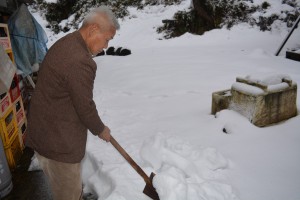Hiroko Obara, Junichi Miura
The number of deaths related to snow has topped 100 for three consecutive years since fiscal 2010, and the situation is getting worse every year. Since lower temperature and more snow are predicted this winter, local governments and experts are calling on people to take accident prevention measures such as avoiding removing snow from rooftops without help from neighbors.
Earlier this month, a man in his 70s of Kamo, Niigata Prefecture, died after falling down from a rooftop when he was removing 30-cm-deep snow from a vulnerable tin roof of a work shed all by himself.
According to Tadatsugu Tsurumaki, head of the residents’ association of the district which the accident occurred, people are supposed to wear helmets and safety belts when removing snow, but few actually take the trouble to do so.
The Kamo city government distributed to all households in the city a pamphlet with points to take note of during snow removal. It also offers JPY10,500 assistance up to three times a year for simultaneous snow clearing activities in districts and for elderly people who have difficulty doing it themselves.
Toshio Yasunaka, a 75-year-old farmer, said he does not want young people to engage in the dangerous task of snow removing, but cautioned that elderly people tend to become careless as they are used to the work. Since snowfall is likely to intensify as the winter deepens, he called on people not to underestimate the dangers of snow removal related accidents.
The Fire Defense Agency reported that the number of snow-related deaths, which was about 40 a year in average, has topped 100 for three consecutive years since fiscal 2010. 80 percent of the deaths occurred during snow removal, and 70 percent of them were aged 65 or older. To avoid accidents, the agency calls on people to work in a group of two or more, fix the ladder and take a mobile phone with them when removing snow.
Five snow removal related deaths have already occurred this winter in such areas as Daisen and Higashinaruse in Akita Prefecture. Injuries caused by being caught in snowplows are also reported. Earlier this month, two accidents involving cutting off of a finger by a rolling blade of a snow blower were reported in Obanazawa and Funagata in Yamagata Prefecture.
The Consumer Affairs Agency recommends using snow shovels when scraping off snow stuck inside a snow plow, making sure that the machine is turned off and the blades have completely stopped rolling.
Seiji Kamimura, associate professor at Nagaoka University of Technology, analyzes that snow-related accidents are taking place at various circumstances, but they all have one thing in common: overconfidence. He says that rooftops tend to become slippery on warm, sunny days and also when sleet falls, so people should be careful even when there isn’t much snow. People should also be especially careful when they remove snow from a roof of a garage or a warehouse which is more vulnerable, he adds.
(Dec. 25, 2013)


